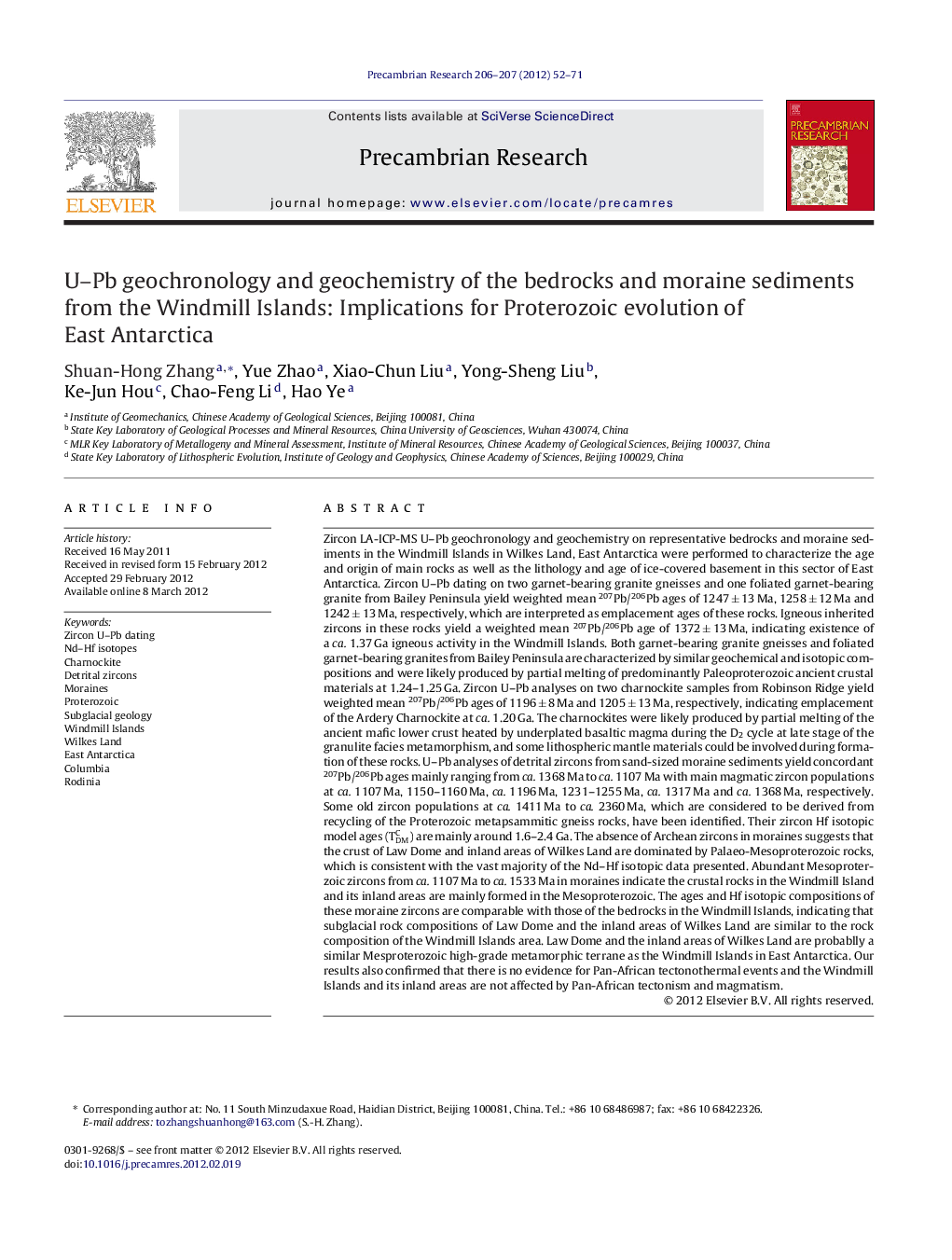| کد مقاله | کد نشریه | سال انتشار | مقاله انگلیسی | نسخه تمام متن |
|---|---|---|---|---|
| 4723555 | 1639657 | 2012 | 20 صفحه PDF | دانلود رایگان |

Zircon LA-ICP-MS U–Pb geochronology and geochemistry on representative bedrocks and moraine sediments in the Windmill Islands in Wilkes Land, East Antarctica were performed to characterize the age and origin of main rocks as well as the lithology and age of ice-covered basement in this sector of East Antarctica. Zircon U–Pb dating on two garnet-bearing granite gneisses and one foliated garnet-bearing granite from Bailey Peninsula yield weighted mean 207Pb/206Pb ages of 1247 ± 13 Ma, 1258 ± 12 Ma and 1242 ± 13 Ma, respectively, which are interpreted as emplacement ages of these rocks. Igneous inherited zircons in these rocks yield a weighted mean 207Pb/206Pb age of 1372 ± 13 Ma, indicating existence of a ca. 1.37 Ga igneous activity in the Windmill Islands. Both garnet-bearing granite gneisses and foliated garnet-bearing granites from Bailey Peninsula are characterized by similar geochemical and isotopic compositions and were likely produced by partial melting of predominantly Paleoproterozoic ancient crustal materials at 1.24–1.25 Ga. Zircon U–Pb analyses on two charnockite samples from Robinson Ridge yield weighted mean 207Pb/206Pb ages of 1196 ± 8 Ma and 1205 ± 13 Ma, respectively, indicating emplacement of the Ardery Charnockite at ca. 1.20 Ga. The charnockites were likely produced by partial melting of the ancient mafic lower crust heated by underplated basaltic magma during the D2 cycle at late stage of the granulite facies metamorphism, and some lithospheric mantle materials could be involved during formation of these rocks. U–Pb analyses of detrital zircons from sand-sized moraine sediments yield concordant 207Pb/206Pb ages mainly ranging from ca. 1368 Ma to ca. 1107 Ma with main magmatic zircon populations at ca. 1107 Ma, 1150–1160 Ma, ca. 1196 Ma, 1231–1255 Ma, ca. 1317 Ma and ca. 1368 Ma, respectively. Some old zircon populations at ca. 1411 Ma to ca. 2360 Ma, which are considered to be derived from recycling of the Proterozoic metapsammitic gneiss rocks, have been identified. Their zircon Hf isotopic model ages (TDMC) are mainly around 1.6–2.4 Ga. The absence of Archean zircons in moraines suggests that the crust of Law Dome and inland areas of Wilkes Land are dominated by Palaeo-Mesoproterozoic rocks, which is consistent with the vast majority of the Nd–Hf isotopic data presented. Abundant Mesoproterzoic zircons from ca. 1107 Ma to ca. 1533 Ma in moraines indicate the crustal rocks in the Windmill Island and its inland areas are mainly formed in the Mesoproterozoic. The ages and Hf isotopic compositions of these moraine zircons are comparable with those of the bedrocks in the Windmill Islands, indicating that subglacial rock compositions of Law Dome and the inland areas of Wilkes Land are similar to the rock composition of the Windmill Islands area. Law Dome and the inland areas of Wilkes Land are probablly a similar Mesproterozoic high-grade metamorphic terrane as the Windmill Islands in East Antarctica. Our results also confirmed that there is no evidence for Pan-African tectonothermal events and the Windmill Islands and its inland areas are not affected by Pan-African tectonism and magmatism.
► We first examined the moraine sediments in the Windmill Islands in East Antarctica.
► Age and Hf isotopic compositions of the moraine sediments are similar to those of the Windmill Islands.
► The granite gneisses in the Bailey Peninsula were emplaced at 1.24–1.25 Ga.
► The Ardery Charnockite is likely a cluster of multiple intrusions emplaced at ca. 1.20–1.16 Ga.
► No Pan-African zircons have been identified from the moraine sediments.
Journal: Precambrian Research - Volumes 206–207, June 2012, Pages 52–71